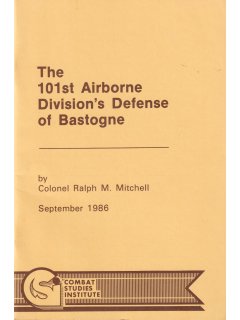The 101st Airborne Division's Defense of Bastogne, Combat Studies Institute
- Κωδικός Προϊόντος: D24627 [24627]
- Διαθεσιμότητα: Άμεσα Διαθέσιμο!
- Ημ/νια προσθήκης: 24/11/2022
-
9,00€
First published in 1986. An in-depth analysis of the Battle of Bastogne, focusing on the ability of a light division to defeat heavier ones, leads to predictable conclusions. At Bastogne, well-coordinated combined arms teams defeated uncoordinated German armored and infantry forces committed to an unrealistic plan. Results of isolated cases in which American infantry fought German armored forces point out how important the attached package of tanks and tank destroyers was to the 101st. The infantry, fighting alone, would have lost Bastogne early in the battle. Coordinated German attacks in mass, rather than the small unit attacks they employed, might also have resulted in a decisive German victory over the 101st and its attachments. In the final equation, moral strength, luck, and the 'fog of war' must also be considered. The Americans had advantages in all of these categories. The right combination of events and situations- conditions unfavorable to the Germans and favorable to the Americans-produced the American victory at Bastogne. At Bastogne, a light infantry division, properly augmented by good artillery and armor support, was able to defeat a numerically superior and heavier opponent. But the conditions of that victory were particular, not universal in application.
Συγγραφέας: Colonel Ralph M. Mitchell
Περιγραφή: Σελ. 58, μαλακό εξώφυλλο, 22,5 X 15,5 εκ.
Κατάσταση: ΠΟΛΥ ΚΑΛΗ+
Βάρος κατά την αποστολή: 250 γρ.

